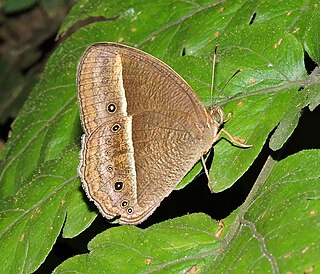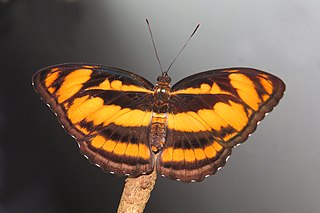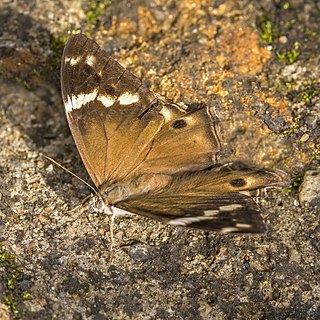
Mycalesis anaxias, the white-bar bushbrown, is a species of satyrid butterfly found in South and Southeast Asia. In South Asia, it inhabits Sikkim, eastwards through the hill-ranges to Assam, Cachar, Myanmar and Tenasserim. Also in southern India, in the Nilgiris and Travancore.

Athyma selenophora, the staff sergeant, is a species of nymphalid butterfly found in tropical and subtropical Asia.

Colotis fausta, the large salmon Arab, is a small butterfly of the family Pieridae, that is, the yellows and whites, which is found in Israel, Syria, Turkey, Iran, Afghanistan, Turkmenistan, India, Arabia, Chad, Somalia and United Arab Emirates.

Jamides kankena, the glistening cerulean, is a small butterfly found in India that belongs to the lycaenids or blues family.

Mycalesis perseus, the dingy bushbrown or common bushbrown, is a species of satyrine butterfly found in south Asia and southeast Asia.

Mycalesis mineus, the dark-brand bush brown, is a species of satyrine butterfly found in Asia.

Mycalesis subdita, the Tamil bushbrown, is a satyrine butterfly found in south India and Sri Lanka. It is not resolved whether this is a good species or is a subspecies of Mycalesis visala.

Mycalesis mestra, the white-edged bushbrown, is a species of satyrine butterfly found in Asia

Mycalesis malsarida, the plain bushbrown, is a species of satyrine butterfly found in Asia.

Mycalesis nicotia, the brighteye bushbrown, is a species of satyrine butterfly found in Asia.

Athyma nefte, the colour sergeant, is a species of brush-footed butterfly found in tropical South and Southeast Asia.

Lethe drypetis, the Tamil treebrown, is a species of Satyrinae butterfly found in south India and Sri Lanka.

Ypthima baldus, the common five-ring, is a species of Satyrinae butterfly found in Asia.

Ypthima huebneri, the common fourring, is a species of Satyrinae butterfly found in Asia.

Vindula erota, the common cruiser, is a species of nymphalid butterfly found in forested areas of tropical South Asia and Southeast Asia.

Stichophthalma camadeva, the northern jungle queen, is a butterfly found in South Asia that belongs to the Morphinae subfamily of the brush-footed butterflies family.

Stichophthalma nourmahal, is a South Asian butterfly that belongs to the Morphinae subfamily of the brush-footed butterflies family.

Stichophthalma sparta, the Manipur jungle queen, is a butterfly found in South Asia that belongs to the Morphinae subfamily of the brush-footed butterflies family.

Discophora sondaica, the common duffer, is a species of nymphalid butterfly found in Southeast Asia.

Junonia iphita, the chocolate pansy or chocolate soldier, is a butterfly found in Asia.




















